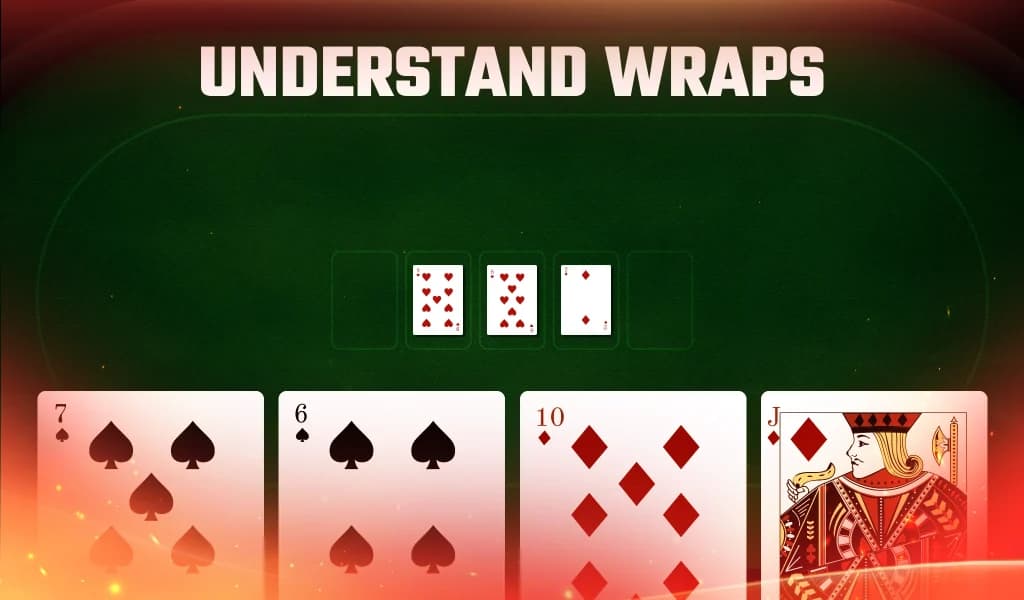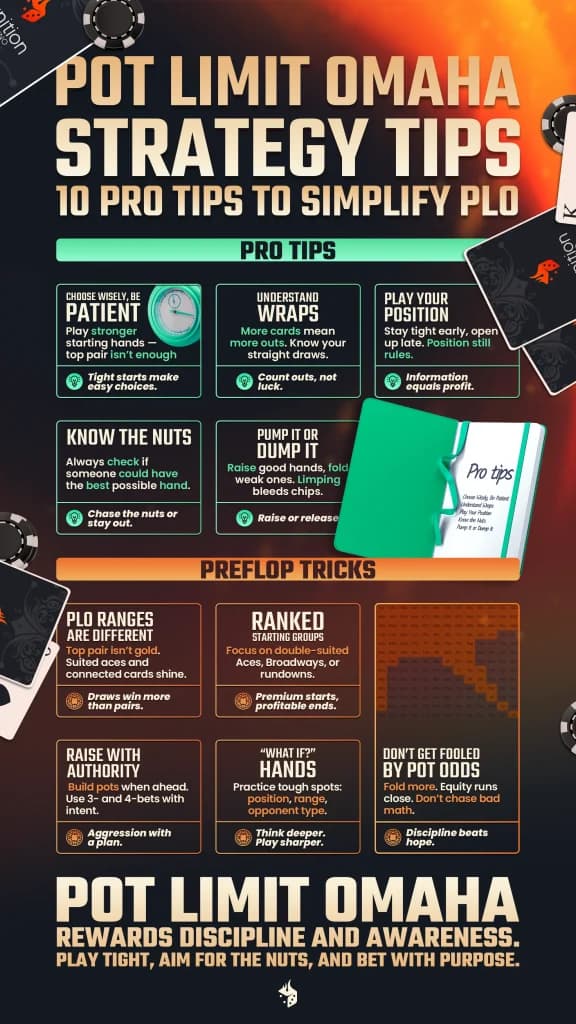
If you’re just dipping your toes in the water with Pot Limit Omaha (PLO), it may seem like a beautiful mess. First off, there’s more cards. You have four hole cards instead of two, as in Texas Hold’em. There’s also more action, and this can mean more headaches. However, it all makes for way more opportunities if you can get these valuable Pot Limit Omaha strategy tips down.
To help you get in the game, we have two PLO poker strategy videos. One has five pro tips, and the other is focused on preflop action. Let’s break down the first one to start:
Video 1: Pot Limit Omaha Strategy – 5 Pro Tips
1. Choose Wisely and Be Patient
In Hold’em, a lot of the time, players plan to outplay the opposition. That’s much less viable in Omaha. Here, you need better starting standards and have much less power to outplay other players. Showdowns tend to have bigger hands (straights, flushes, etc.), and so hitting top pair is nowhere near as valuable as it is in NLHE. It all starts at the beginning of the hand, so use good starting hand standards and don’t continue if you don’t have a nice hand or a big draw. That’s how you set yourself up for success.
2. Understand Wraps
Straight draws in Hold’em are either open-ended (7-8-9-10) or gutshot (7-8-10-J). In Omaha, wrapping straight draws (aka “wraps”) adds another dimension to the game. Because you have so many cards in your hand, you can have straight draws with tons of outs. For example, if the board is 8♥ 9♥ 2♦ and your hand is 7♠ 6♠ T♦ J♦, you have a made straight, but can also make more straights if a five falls (you’d have the nut straight there), a queen falls, or a queen-king fall (you’d be on the short end of that straight).
You need to spend time understanding the math behind wraps if you want to play these multiway hands. Many players may be chasing action here, and you need to know how your hand compares to the other ranges at the table.

3. Play Your Position
In PLO, the betting is limited, so you might be tempted to limp from early position a lot. This would be a mistake. Just because wagers are capped, you don’t want to get in the habit of leaking chips into the pot. Late position is still quite valuable, and you want to focus on playing hands where you get info on which players are entering the hand, who is raising, and more. Don’t let the limit lull you into complacency. Tighten early, open up late. Poker fundamentals are still essential in PLO strategy.
4. Know the Nuts
This might be the biggest mindset shift from Texas Hold’em. In Hold’em, you can really win with anything, especially when you can isolate a player out of position and use aggression to drive the action. This happens a lot less in Pot Limit Omaha.
Here, you’ll have to always be aware of how the huge number of cards available influences the chances that a player has the nuts, or near to it. Someone could be planning to play two of their cards on the flop, and switch to their other two cards as a flush is made on the river. Stay aware of the best hand. You will need something close to it quite often.
5. Pump It or Dump It
The power of the bluff is really reduced in PLO. Not only are bet sizes capped, preventing you from making a huge no-limit move, but everyone is chasing big hands. It’s really hard to push competitors out in situations like that. So again, don’t be in the habit of limping a lot. Raise good hands for value, and fold weak ones to avoid leaks. It’s straightforward poker, and that’s part of the relaxing charm of this game. You don’t have to sweat bullets playing PLO, but you need to play disciplined.
Video 2: Pot Limit Omaha Strategy – 5 Preflop Pro Tricks
In addition to those strategy tips, we’ve also got a video focused just on preflop action:
1. PLO Ranges Are Different
As we’ve been saying above, PLO does not really reward maverick moves as much as Hold’em does. Fancy plays and putting a lot of money in the pot with marginal hands just won’t work. You need to be more selective and tighten up in the sense that top pair is no longer your spouse. You should be drawing to something substantial in most hands, or you’re probably wasting your money. Suited aces are nice, as are connected cards. That overpair of queens isn’t doing much heavy lifting in Pot Limit Omaha.
2. Ranked Starting Hand Groups
These are good to know when you’re new to PLO and coming from Hold’em. The best starting hands to have are things like double-suited Aces, double-suited Broadway combos, and premium rundowns (e.g., J-10-9-8). Cards like these draw to monster hands and just offer so much equity, by the numbers.
It is essential to be able to group hands by strength to know what you’re getting into. Those double-suited queens and middling connectors might make sense, but only in late position or other specific scenarios. Don’t play weak hands, or you’re going to be slowly trickling chips into a competitor’s stack.

3. Don’t Get Fooled by Pot Odds
This is a bit of a post-flop point, but pot odds work differently here. In Hold’em, you probably got used to those 1:4 and 1:5 draws on the flop and calculating whether you can get away with seeing another card. In PLO, everyone has a lot of cards, and it can be quite hard to assess whether you’re ahead, especially because bets and raises are limited. You’ve got to fold more, limp less, and raise when the raising is good. Do not chase hands just because they look “playable.” Equities of multiple hands are running closer than you think.
4. Raise With Authority (and 4-Bet With Intent)
Raising preflop in PLO does two things: it increases the pot size when you’re ahead, and can somewhat thin the field as well. It’s still possible to isolate opponents, so you should sometimes shoot for this goal if the situation calls for it. This can mean 3- and 4-betting when appropriate (e.g., when you have double suited aces or a powerful rundown). The 4-bet bluff is not totally off the table, but you better use it sparingly be against tight players who will believe it.
5. “What If?” Hands
Time to practice what you’ve learned and apply it to real hands. Do you raise if you’re first to act with double-suited Aces? Should you dump single-suited Queens when trapped between players that are splashing the pot? How do you play rainbow Aces in late position? These questions force you to apply concepts and think deeper about your position, hand strength, and opponent tendencies.



